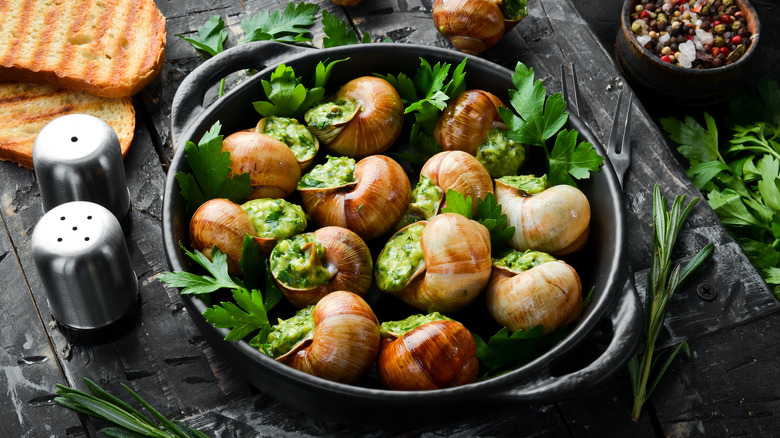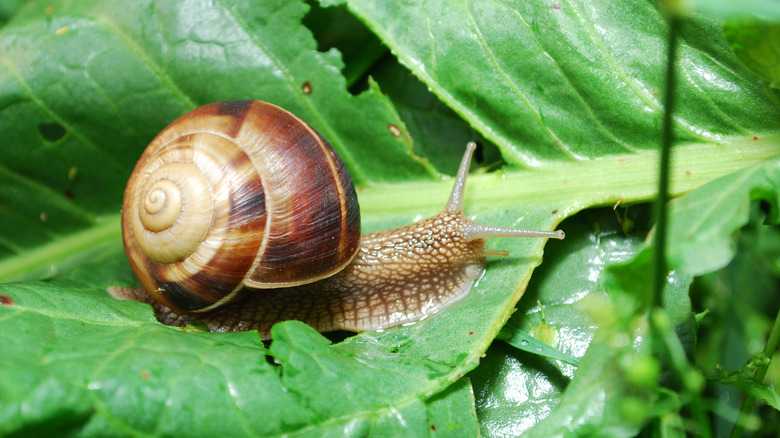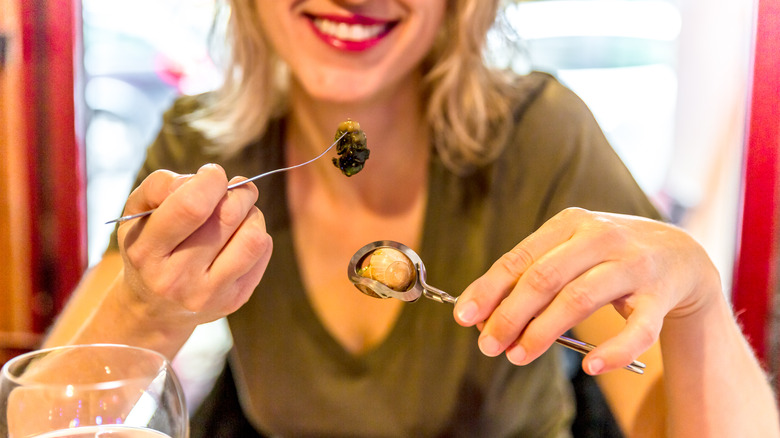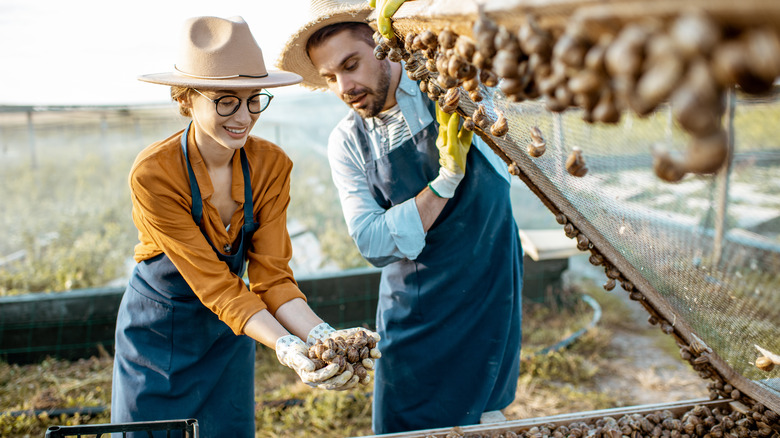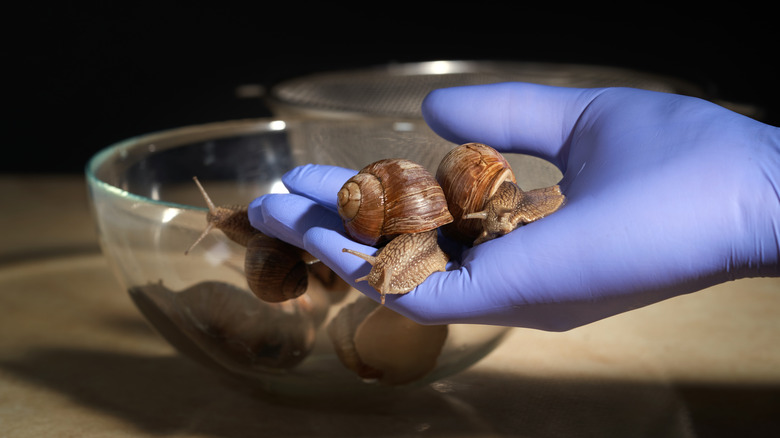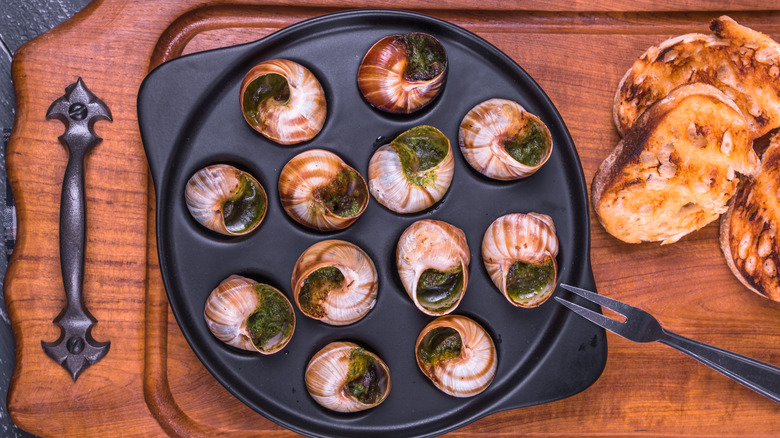What Is Escargot And How Is It Served?
We may receive a commission on purchases made from links.
If you're ever in a chic French restaurant perusing the hors d'oeuvres, you may see a dish that's listed called escargot. Should you ask your server what is in this dish, prepare for a shocker — escargot is the French word for snail. And yes, it is a literal translation. Those are actual snails you'll see on your plate, should you be brave enough to order les escargots. To be specific, the snails you'll be eating will likely belong to one of two species — either Helix pomatia or Helix aspersa.
Although the thought of eating snails may seem off-putting at first, escargots are actually quite delicious. Snails were gourmet fare in ancient Rome where they first practiced heliciculture — this is the official term for snail farming, in case you need it for a crossword puzzle (via Escargot World). In fact, Roman snails were kind of like the Kobe beef of their day, pampered with a diet of meat and wine. From Rome, the snail-eating habit spread throughout the Empire, but it was in France where it really caught on and was adopted as a favorite national dish (via Travel Food Atlas).
Why you should be eating escargot
Snails are quite a healthy source of meat, being low in fat and high in protein (and also water, so you won't get too dehydrated should you ever be stranded on a snail-infested desert island). Also, if it makes you feel any better, snails are not actually insects. Rather, Britannica lists them as mollusks, which makes them more closely related to clams, oysters, and squid than to multi-legged creepy-crawlies.
According to the U.S. Department of Agriculture, a 3 ounce serving of cooked escargot, sans shells, would contain about 120 calories, 16 grams of protein, 4.5 grams of fat, 2 grams of carbohydrate, and 330 mg of sodium. Snails are also a decent source of iron, with about 3.5 mg per serving, as well as magnesium (253.5 mg per serving), phosphorus (276 mg per serving), and potassium (390 mg per serving). Escargot is also rich in tryptophan, meaning they may work as a mood booster or make you sleepy.
How does escargot taste?
Believe it or not, this seemingly bizarre dish turns out to be pretty darn delicious. The flavor of escargot meat itself is fairly mild, but the texture is juicy and just a bit chewy and there's a ton of flavor from the sauce. Still, as with every type of food you could possibly name, not everyone's a fan.
A Quora thread asking about the taste of escargot received some mixed responses. One respondent answered that "It usually has a lot of butter on it, so that is the primary flavor," adding that "texture and taste-wise, I would say it's most similar to clams or oysters but more substantial." Another echoed the idea that "the snail basically only provides the texture, as it is drowned in garlic," but a third Quora user said "I don't recall much of the taste, but the texture was rubbery," as it definitely can be if escargot are overcooked.
Where to obtain escargot
Escargot isn't the kind of thing you can buy at just any old supermarket. You can order them online (Amazon carries everything, after all), but if the online prices give you sticker shock, you might be surprised to know that there's one major retailer that carries escargot in its stores — believe it or not, it's Walmart. While canned escargot come shell-less, you can purchase the shells separately if you'd like to serve them this way. You can also buy fresh snails at some seafood markets, but Mother Earth News says you can also harvest a domestic version.
While commercially-available snails tend to be of the Helix pomatia variety, Helix aspersa, the type commonly found in American (and French) gardens, is also eaten in France. Even if your garden features snails of a different species, no worries. Just about any snails both large enough and infesting your garden in sufficient numbers, are likely worth eating if properly prepared. As to how you do the actual harvesting, the outlet suggests leaving a handful of bran under an overturned flower pot, one that you've propped up so the snails can crawl inside. Once they eat the bran, they'll stick themselves to the underside of the pot, and all you'll need to do is peel them off.
How to prepare escargot for cooking
If you've bought canned escargot, they are recipe-ready, apart from the potentially tricky part of having to insert them into the shells if you've also purchased this accessory. As the shells are just for show, though, you can easily skip this step. If your escargot have been purchased or harvested fresh, so fresh that they are still alive and squirming, well, in that case things get a lot more complicated.
Before you're ready to cook your snails, they should be kept in a lidded bucket with breathing holes. Ten days before you plan to eat them, feed them lettuce and provide a dish of fresh water. Three days before the snails are cooked, they should stop eating solid food, but you can, if you want to be fancy, swap out their water for wine. A few hours before cooking, de-slime the snails by covering them with water in which you've mixed two tablespoons of salt and one of vinegar for each dozen snails. It should take about four hours for the snails to release their slime, at which point you can rinse them, parboil them for 10 minutes, then remove them from their shells. It's important to note that the garden shell snails aren't tough enough to stand up to baking, so you'll likely want to peel the shells off. You can then either use the snails as-is or stuff them into store-bought shells, although you may need two snails to fill each shell.
How escargot is served
Escargot are more likely to be served as an appetizer, rather than a main course. One of the most common preparations involves butter, garlic, and parsley, and you'll want to use plenty of bread to soak up every last drop of sauce. Other preparation methods include adding red wine and shallots or smothering them in tomato confit.
If you are eating escargot served in the shell, the proper way to extract the meat is with an escargot fork — a utensil that's meant to reach into the shell's chamber and help you dig out the hidden treasure. Escargot in or out of the shell may also be served in a special escargot dish with an indentation for each one, or they may be served atop toasted bread. However it is served, the best part about eating escargot is that it gives you enough solid adventure-eating cred to make Andrew Zimmern proud without being at all gross. In fact, escargot may well be one of the tastiest things you've ever been glad you were brave enough to try.
